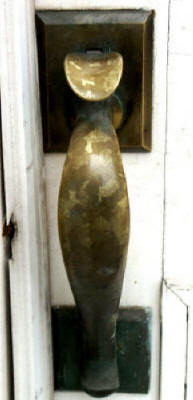Brass Corrosion
These alloys contain zinc as the principal alloying element with or without other designated alloying elements such as iron, aluminum, nickel and silicon. The wrought alloys comprise three main families of brasses. The cast alloys comprise five main families of brasses. Ingot for remelting for the manufacture of castings may vary slightly from the ranges shown. In these alloys, zinc is added to copper in amounts ranging from about 5 to 45%. As a general rule, corrosion resistance decreases as zinc content increases. It is customary to distinguish between those alloys containing less than 15% zinc (better corrosion resistance), and those with higher amounts. A modern and comprehensive document on the subject is the second edition of the classic CORROSION BASICS textbook.
 The main problems with the higher zinc alloys are
dezincification and
stress corrosion cracking (SCC). In dezincification, a porous
layer of zinc free material is formed locally or in layers on the surface. Dezincification
in the high-zinc alloys can occur in a wide variety of acid, neutral and alkaline
media. Dezincification can be avoided by maintaining the zinc content below about
15%, and minimized by adding 1% tin such as in Admiralty
brass (C44300) and Naval brass (C46400). Adding less than 0.1% of arsenic, antimony
or phosphorus gives further protection, provided the brass has the single a-phase
structure.Again, a decrease in the zinc content to less than 15% is beneficial.
Brasses containing less than 15% zinc can be used to handle many acid, alkaline
and salt solutions, provided:
The main problems with the higher zinc alloys are
dezincification and
stress corrosion cracking (SCC). In dezincification, a porous
layer of zinc free material is formed locally or in layers on the surface. Dezincification
in the high-zinc alloys can occur in a wide variety of acid, neutral and alkaline
media. Dezincification can be avoided by maintaining the zinc content below about
15%, and minimized by adding 1% tin such as in Admiralty
brass (C44300) and Naval brass (C46400). Adding less than 0.1% of arsenic, antimony
or phosphorus gives further protection, provided the brass has the single a-phase
structure.Again, a decrease in the zinc content to less than 15% is beneficial.
Brasses containing less than 15% zinc can be used to handle many acid, alkaline
and salt solutions, provided:
-
There is a minimum of aeration
-
Oxidizing materials, such as nitric acid and dichromates, and complexing agents, such as ammonia and cyanides, are absent
-
There are no elements or compounds that react directly with copper such as sulfur, hydrogen sulfide, mercury, silver salts, and acetylene.
Brass is also konwn for its tendency to tarnish, as shown in the picture on the right, when not protected from the environment. Similar to rust, tarnish is a feature that is both loved and hated by brass lovers. Salt, in particular, tarnishes brass quickly and must be kept away from brass intended to be kept shiny. Chemicals in rainwater, tap water and air, as well as those found on our fingers and in food, are also corrosive.

Connect with us
Contact us today